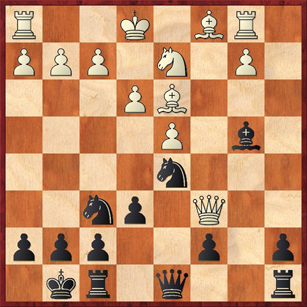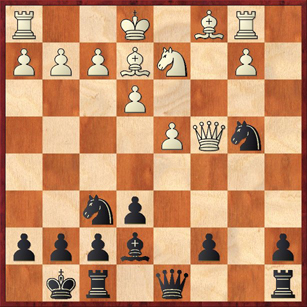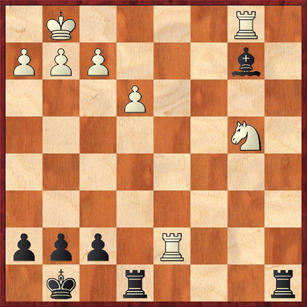So far I have had time to thoroughly analyze only two of my games from the U.S. Championship Qualifier, and I’m part way through the third. I had an unusual number (by my standards) of very interesting and competitive games, and I think that I will eventually end up putting five of them on this blog. I’ve already shown you some highlights from my game in round one, so let’s move on to round two.
In this game I played Black against John Bick, a master from New Orleans. We had both lost in round one, but his victory in this game catapulted him to a very good tournament. He won four games in a row, to ascend all the way to board five. In round six he lost to Dean Ippolito, and in round seven he drew with Ron Burnett to end with 4.5-2.5, a very respectable result for a player rated around 2250 or so.
One always wonders, “What if… ?” If I had found the right move in the opening of this game, I think I would have won at least a pawn and would have had great winning chances. If I had won the game, would I have gotten on a roll and maybe finished with 4.5, like he did? We’ll never know.
The game started out wonderfully for me, as he played into my home analysis in the Marshall Variation of the Queen’s Gambit Declined. (See my ChessLecture, “Fun With a Supposedly Inferior Opening.”) The game began:
1. d4 Nf6 2. c4 d5?! 3. cd Nxd5 4. Nf3 Bf5 5. Qb3 e6!?
This is the first non-book move, and it is a key to why this opening is playable for Black. Taking the b-pawn actually turns out to be very problematic for White, as we’ll see. And if White can’t take the b-pawn, then what was the point of playing 5. Qb3?
6. a3 Nbd7 7. Qxb7?! …
Quiz #1: Black to play and win back his pawn by force.
This is an exceedingly neat idea that I cannot take credit for — Fritz found it for me. But in our modern age, that is how many opening innovations are born.
A few moves later we got to this position:
 Quiz #2: Black to play and gain a large advantage (a pawn, or a tremendous attack).
It seems as if in each game I lost this tournament, there was one move that I regretted more than any other. Here is my biggest regret from this game. I played the superficial move 12. … Be7? with the idea of forking his queen and bishop. Unfortunately, it was very easy for him to defend this “threat,” with 13. Qc4 Nb4 14. Be2.
Why was this move 12. … Be7 so bad? Let’s take a look at this position. Black has completed his development and castled. White has not finished his development, and his king is still in the center. The pin on the knight on d2 is very awkward for White, as it keeps his bishop pent up. His kingside is also relatively lightly defended at the moment. It all adds up to the fact that now is exactly the right time for Black to strike. If White is allowed to castle and move his knight, he should be able to consolidate the position, and then his two bishops may offer him some advantage even. Repeat: Black must play energetically right now.
Here’s another big clue toward finding the right move: look for undefended pieces. Which White piece is undefended? How can Black open lines to attack it?
By now I am sure that you have solved the problem. So now let’s go on to the position after 12. … Be7? 13. Qc4 Nb4 14. Be2:
Quiz #3: What is Black’s best move? Don’t take more than 30 seconds on this.
Here I again made a mistake, which was a mirror image of the last one. My mistake on move 12 was caused by not thinking deeply enough, and this one was caused by thinking too much. In this position the correct move is obvious. I looked at it for probably at least eight minutes — and talked myself out of it. How frustrating chess is! Sometimes I think too much, sometimes I don’t think enough. How are you supposed to figure out which is which?
Instead of the obvious correct move that I’m sure you have found, I played 14. … Rc8 15. Nb3 Qd5 16. Qxd5 ed. Incidentally, Bick said after the game that he thought this pawn capture was a mistake. I don’t agree. I think it’s very useful for Black to establish a pawn beachhead in the center. It helps keep White’s two bishops bottled up. I made plenty of mistakes in this game, but 16. … ed was not one of them.
Let’s go on to our next position.
Quiz #4: Black to play and stay in the game.
Here Bick has just played 23. Bg4!, a nice move that I had not expected. One point is that if Black plays 23. … Rc7, the most natural move, then White plays 24. Ra1. Black cannot defend the a-pawn with a rook, because he loses his knight on b4. So I played what I thought was the only other move, 23. … Ra8, but I lost a pawn after 24. Bxb4! ab 25. Nc6 Re8 (Note that 25. … Rd6? would lose two pawns after 26. Nxb4 Rb8 27. Nxd5. The threat of Nxf6+ or Ne7+ prevents Black from capturing on b2 either way.) 26. Rxd5 (not 26. Nxb4?? Re4, forking White’s two undefended pieces. Once again, undefended pieces are an important theme to keep in mind.)
So you’ve seen the two moves that don’t work, 23. … Ra8 and 23. … Rc7. What is the move for Black that does work? It doesn’t lose any material, and Black is left with a very playable game.
The last interesting position in the game came on move 30. Although I’ve lost a pawn, I have at least liquidated all the queenside pawns. With all the pawns on one side of the board, I may have some hope of drawing.
Quiz #5: Suggest some good options for Black.
Here I rushed needlessly with 30. … Ra1? There is no need to play this move yet, none at all. White isn’t threatening to take the bishop on b2 yet. So I should have asked myself, what constructive, useful move can I play to improve my position before I think about … Ra1? It might help you to see what White played after 30. … Ra1: 31. Rxa1 Bxa1 32. g4! The moment I saw him play this move I realized I was in a lot of trouble. The g-pawn will most likely advance to g5 and severely cramp Black’s kingside. Is there anything I could have done to prevent this?
The game continued 32. … h6 33. Nd5 g6 34. Kg2 Kg7 35. f4 Bb7 36. Kf3 Re6. At this point I stopped keeping score because I was low on time (I did not yet realize that you are supposed to keep score regardless, because of the 30-second time increment). This position is obviously very bad for Black: a pawn down, White’s pieces in dominating positions, there is very little Black can do to prevent e4-e5 and maybe e6, and White can even chase Black’s bishop away from the long diagonal on this move. Bick eventually won 15 or 20 moves later.
Quiz answers:
- The combination 7. … Bxb1 8. Rxb1 Bxa3! wins back the pawn. White cannot take with 9. ba because of 9. … Rb8 skewering the queen and rook. A wonderful idea, and you will look for it in vain in any opening book. Instead, Bick played 9. Qc6 Bb4+ 10. Nd2? (Too slow. White wanted to keep the two bishops, but he just can’t afford the lag in development that results from this move.) O-O 11. e3 N7f6 12. Bd3, arriving at the second quiz position.
- After the hints, you should not have had any difficulty spotting the move 12. … e5! The main point is that after 13. de Nxe6! White cannot win a piece because his bishop is hanging on d3. Moreover, after Black takes on d3 he just has a huge variety of threats:Â checking on e3, taking on b1, or (probably the most important threat) checking on d2 followed by taking on b1 and winning two rooks. White absolutely cannot afford any of this, so after 12. … e5 he has to castle. But on 13. O-O ed 14. ed Nf4 I think that White is already unable to defend his d4 pawn.
- Of course the best move is 14. … c5. If you did not see this move, at least as a possibility, in 30 seconds, then you need to brush up on pawn levers. There are some complications after 15. dc — Black can’t just play 15. … Rc8 because his knight is hanging — but 15. … Qa5! both defends the knight and wins back the pawn. If 16. Nb3? Nd3+! 17. Kd1 (forced; if 17. Kf1 Qe1 mate!) Nxf2+ 18. Kc2. Black can’t win the rook because his queen is hanging, but after 18. … Qc7 19. Rf1 N2e4 Black is clearly in the driver’s seat. The crazy thing is that I saw all this, but I talked myself out of playing this variation because after 16. O-O (instead of 16. Nb3) Qxc5 17. Qxc5 Bxc5 18. Nb3 I didn’t think I had any advantage any more. Actually, this last assessment is very debatable. After 18. … Bb6 my bishop is well posted and White still hasn’t solved all of his development problems. But even if it’s true that White can equalize here, Black is certainly no worse and this is certainly the line that had to be played.
- The move I missed was 23. … Rb8. Not only did I miss this during the game, I also missed it when analyzing the game at home, when I had all the time I wanted. Why? Well, it looks as if White is just winning the exchange with 24. Bxb4 followed by 25. Nc6, forking Black’s rooks. But actually, 24. Bxb4 Rxb4! 25. Nc6? Rxg4! wins material. Did you remember about that undefended bishop on g4? I certainly didn’t. Of course White doesn’t have to go for this — for instance, he can play 24. h3 defending the bishop — but now Black has time to organize his pieces and get out of trouble. The computer likes 24. … Bxd4 25. Rxd4 Nc6! 26. Rdd1 Nb3! Even though Black has the “disadvantage” of two knights against two bishops, what incredible knights they are! The one on b3, in particular, is totally tying up White’s position (as well as defending the a5 pawn).
- Two constructive moves for Black are 30. … h5 (creates luft, and prevents White’s g2-g4) or 30. … Red8 (getting this rook back on an open file). It’s still a tough position for Black to hold. I must admit that I had completely unrealistic expectations — I actually thought it would be pretty easy to hold. The reason it’s hard is that both of the endgames R+4P versus R+3P and N+4P versus B+3P are normally won for the stronger side. Therefore, to have any hope of drawing, Black needs to keep both a rook and his bishop on the board. I spent about three hours yesterday playing “fantasy chess” from the position after 30. … h5 31. g3 Ra1 32. Rxa1 Bxa1. I would score this position as “¾ of a point” for White. Clearly White has very good winning chances, but Black create a lot more trouble with both his rook and bishop than he could with either one of them alone. I don’t think it’s a 100 percent automatic win for White.
Lots of food for thought in this game! My mistakes really ran the gamut of human fallibility. To Bick’s credit, I don’t think that he made any significant mistakes after move 10.








{ 1 comment… read it below or add one }
Interesting game and a lot hard work. When are the games getting rated? Any idea?
{ 1 trackback }